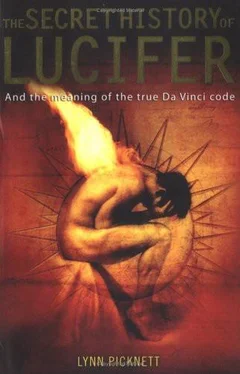In the Gospel of Mary, even Peter is forced to acknowledge her closeness to Jesus, saying `the Saviour loved you more than the rest of the women',56 but not before he had suggested that she had invented the story of meeting the resurrected Christ, thundering incredulously: `How is it possible that the Teacher talked in this manner with a woman about secrets of which we ourselves are ignorant? Did he really choose her, and prefer her to us?"' When Peter calls her vision a lie, naturally:
... Mary wept, and answered him: `My brother Peter, what can you be thinking? Do you believe that this is just my own imagination, that I invented this vision? Or do you believe that I would lie about our Teacher?' At this, Levi spoke up: `Peter, you have always been hot-tempered, and now we see you repudiating a woman, just as our adversaries do. Yet if the Teacher held her worthy, who are you to reject her? Surely the Teacher knew her very well, for he loved her more than us ... Let us grow as he demanded of us, and walk forth to spread the gospel, without trying to lay down any rules and laws other than those he witnessed.'58
Unlike the canonical gospels, several of the Gnostic texts make Jesus' love for the Magdalene crystal clear. Despite the tendency of the Pistis Sophia to indulge in the usual excessively impenetrable Gnostic ramblings about complex realms of heaven and hell, the passages concerning the personal relationships among the disciples read with an unusual clarity and confidence that strongly suggests a single tradition - perhaps beginning with authentic memories of the individuals on the Jesus mission. Christ makes this unambiguous statement to the Magdalene, which must have made the irascible Peter seethe: `Mary, thou blessed one, whom I will perfect in all mysteries of those of the height [the highest mysteries], discourse in openness, thou, whose heart is raised to the kingdom of heaven more than all thy brethren' S9 Later in the same Gnostic text, Christ announces: `Where I shall be, there will also be my twelve ministers. But Mary Magdalene and John the Virgin, will tower over all my disciples and over all men who shall receive the mysteries ... And they will be on my right hand and on my left. And I am they, and they are I.'60
Mary and young John are Jesus' closest apostles who will sit on his right and left throughout eternity - and John the Beloved/Divine/Evangelist will have a special part to play in this investigation. But Mary is more obviously Jesus' favourite, being dubbed `The All' or `The Woman Who Knows All' by him. A clue as to the depth of their relationship is found in this explicit passage from the Gnostic Gospel of Philip:
... And the companion of the Saviour is Mary Magdalene . But Christ loved her more than all the disciples, and used to kiss her often on the mouth. The rest of the disciples were offended ... They said to him, `Why do you love her more than all of us?' The Saviour answered and said to them, `Why do I not love you as I love her?'61
It has been suggested by Christian traditionalists that Jesus was merely kissing Mary in the spirit of agape, or spiritual love - indeed, the Gnostics celebrated their religion at `love-feasts', which were more or less chaste depending on the group. (Of course the Carpocratians' love-feasts were somewhat more colourful.) But if he only meant to give her an affectionate spiritual peck, why did Jesus choose to kiss her on the lips, and why would it have `offended' the others so blatantly? Actually, no one knows where Jesus kissed her because, frustratingly, the ancient gospel is missing that particular bit of papyrus. `On the mouth' is merely a scholarly speculation, but of course it is extremely interesting that even scholars thought fit to suggest the mouth and not the hand or cheek. Of course the original may have said something quite different, such as `on the Sabbath' or `on the Sea of Galilee'! Another passage from the Gospel of Philip is even more intriguing:
Three women always used to walk with the lord - Mary his mother, his sister, and the Magdalene, who is called his companion. For `Mary' is the name of his sister and his mother, and it is the name of his partner [My emphases] 61
The word for `companion' is the Aramaic koinonos, a Greek loan word meaning `partner'. Previously63 when I claimed that this means `sexual partner' there were howls of outrage from certain quarters. I remain unrepentant. I maintain that koinonos means `partner' in exactly the sense of our modem word, which depends almost entirely on context for its nearest definition. If someone is introduced as `partner' in an office setting, it will be assumed this means business associate. If at a party, `lover' is more likely to fit the bill 6' Here we have the Magdalene, who elsewhere in the Nag Hammadi texts is described as being repeatedly kissed, presumably on the mouth, by Jesus. She may have controlled the purse strings, but somehow she hardly sounds like a business partner - nor would the modem British `good mate' match the context. (In which case she would probably have been described as `disciple' or `follower'.) Koinonos, in this context, can only mean lover.
The phrase `who is called his companion' is also slightly stilted, perhaps as if some kind of euphemism, as in `who they say is his companion', and Mary is specifically called his partner.
Despite the belief fostered worldwide by Dan Brown's blockbusting thriller The Da Vinci Code that Jesus and the Magdalene were man and wife - a concept that first reached the Anglo-Saxon public in 1982 in Michael Baigent, Richard Leigh and Henry Lincoln's The Holy Blood and the Holy Grail - there is little to support this view, either in the Bible or, more tellingly, even in the Gnostic writings. The miracle of the turning of the water into wine at a marriage at Cana, said to be the wedding of Jesus and Mary, originally - as we have seen - came from the myths of the dyingand-rising wine god Dionysus 65 And the single most important piece of evidence for their not being married is one of glaring omission: simply, there is no mention of a `Miriam, wife of the Saviour' or `Mary, Christ's spouse' in either the New Testament or any of the known Gnostic writings. Although there was a conspiracy to marginalize her in the Gospels of Saints Matthew, Mark, Luke and John, it seems that it did not extend to air-brushing out her marital status. Indeed, the obvious distaste the male disciples feel for her may partly arise from the fact that her relationship with Jesus was not sanctioned by Jewish Law.
In any case, Jesus' disciples were forbidden to marry - although John the Baptist's followers were not - and there are other possible considerations that would prevent Christ `making an honest woman' of her. Unacceptable and unthinkable though such considerations may be, either or both of them could already have been married, or they may have been close blood relatives - too close to make their love legal. Or one or both of them could have been dedicated to chastity, most likely as priest or priestess of a foreign cult. (Even temple `prostitutes' or servants were expected to remain unmarried and observe the sexual rites only within the temple walls.) The thirteenth-century citizens of Beziers in the south of France - all 20,000 of them - willingly died martyrs' deaths rather than recant a belief that Mary was Jesus' 'concubine', which they probably gleaned from Gnostic gospels that were circulating in the area at that time, but which have since been lost 66
The Magdalene's closeness to Jesus, her relationship with `John the Beloved', and Peter's hatred, are all significant factors in her emergence as `Mary Lucifer' - for better or worse in the minds of future generations. And in order to piece together her true significance, we need to fast-forward to the late fifteenth century, where one of the world's most famous figures was concocting works of the most outrageous blasphemy.
Читать дальше












